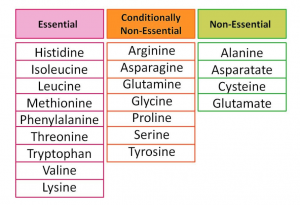Fuel for Thought
Weekly Column By Barb Bryan, BSc(Pharmacy), BSc(Nutrition) APA PRESCRIBING RIGHTS
Macronutrients – Part 4 in a 6-part series
The Power of Protein – Macronutrient #2
“Macronutrient” is an all-encompassing term for the three types of nutrients that make up the bulk of what we eat and they are carbohydrates, protein, and fat. We have focussed on the importance of carbohydrates in the previous installments of this series so far. This week we will switch our focus to the second macronutrient: protein.
To really understand why protein is vital, we must dig a little deeper. It’s important to address some background information about protein. In Greek, protein means “primary” or “holding the first place”—a feat many athletes aspire to achieve. Protein is involved in numerous biochemical processes including building and repairing tissues (including muscle), supplying the building blocks for enzyme synthesis and immune system proteins and maintaining body fluid balance.
What exactly is a protein? Proteins are comprised of small building blocks called amino acids that are linked together by peptide bonds to form long chains. These amino acid combos can be quite extensive. For instance, Titin, a giant protein that functions as a molecular spring which is responsible for the passive elasticity of heart muscle, contains 34,350 amino acids. It’s the largest protein molecule found, and it has the longest chemical name containing 189,819 letters. It would take you three and a half hours to pronounce correctly. Seriously. University of Calgary professor of kinesiology, engineering, medicine and veterinary medicine, Walter Herzog, has been leading efforts in describing Titin’s mechanical properties and its role in muscle contraction. Wow!!! These amino acids are typically called “The Building Blocks of Life” – Very powerful statement!
Protein Synthesis: The process cells use to create proteins
It might help to think of a dietary source of protein (e.g. an egg) as a brick house, with the individual bricks that make up the house being amino acids.
- Brick House = Protein (Egg)
- Bricks that make up the house (Egg) = Amino Acids
During protein synthesis, the brick house (protein) is eaten – the bricks (amino acids) are dismantled and liberated from the house by the acids of the stomach. These bricks are then absorbed by the small intestines and distributed throughout the body to make new brick houses (proteins) and to extend or repair other existing houses. Some bricks are also used to build tools and means of transport, (e.g. hemoglobin).
Summary – When we ingest protein our body is consistently dismantling them into amino acids, which are absorbed and used by cells to build other required proteins.
There are 20 core amino acids
Amazingly our bodies need only 20 different amino acids to grow and function properly. From these 20 amino acids the body can make thousands of different proteins. The 20 core amino acids can be divided into three categories: essential, nonessential, and conditional.
- Essential – These types of amino acids cannot be made by our body but are necessary for survival. Consequently, we need to get them from our diet. 9 of the 20
- Nonessential – These types of amino acids our bodies can produce. 4 of the 20 in the chart below
- Conditionally Non-Essential – Our bodies can produce these types of amino acids from other nutrients, however, this ability can be significantly reduced during periods of stress and illness. 7 of 20 in the chart below

Where do we get these 20 Amino Acids?
Dietary sources of protein are either “Complete” proteins or “Incomplete” proteins
- Complete proteins are foods that contain every essential amino acid listed above. These proteins include all animal proteins and a few vegan sources.
- Incomplete proteins are foods that lack one or more of the essential amino acids. These proteins include vegan sources such as beans, nuts, hemp seed, chia, grains, and vegetables.
Previously, it was advised that vegans combine foods that contained incomplete proteins at the same meal to give the body all the necessary amino acids it needed at one time. Today we know this is not necessary to do at the same meal. Rather, it can be done in the same day. This is usually accomplished if you have a consistently “varied” plant-based diet. However, if you are an endurance vegan or vegetarian athlete, it’s wise to speak to a nutritionist for careful planning of your diet to meet not only your protein needs, but also other nutrient needs as well.
| Proteins | Food Sources |
| Complete animal proteins | Poultry, red meat, fish, pork, dairy |
| Complete plant proteins | Quinoa, soy, buckwheat, Ezekiel grain |
| Incomplete proteins | Beans, nuts, rice, hemp seed, chia, grains, vegetables |
| Most beans are low in methionine and high in lysine, while rice is low in lysine and high in methionine. If you put them together the protein content will be on par with meat | |
When do we ingest and how much?
If we lack one or more essential amino acid, we are unable to build critical protein structures in the body. In our carbohydrate discussions in Part 1, Part 2, and Part 3 in this series, we learned that carbs can be stored. Unfortunately, our bodies do not have the ability to store protein. After eating protein, our body has a limited amount of time, (possibly only up to 24 hours), to utilize the amino acids made available from our meals. After this period has passed, the body will burn our own precious muscle to obtain more amino acids for protein production. So, when we ingest our protein sources we want to make certain they are “complete” – containing all the amino acids. Therefore, eating protein regularly throughout the day is of paramount importance. Also, The Academy of Nutrition and Dietetics states the ability to synthesize these non-essential amino acids DECLINES as we age, so don’t be afraid to adjust dietary protein intake accordingly.
The American College of Sports Medicine recommends somewhat higher protein intake for endurance and strength athletes: 1.2 to 1.7 grams/kg daily. Some professionals believe an intake as high as 2.0 grams per kilogram of body weight may be necessary to offset the amino acids cannibalized during prolonged extreme exercise. However, be aware that there is no evidence of greater benefit from exceeding a protein intake of 2.0 grams/kg/day.
In general, the longer and harder you train, the more protein you should consume. Some studies have employed a protein pacing strategy involving the equitable distribution of effective doses of protein (4–6 meals/day of 20–40 grams per meal).
Below are a few guidelines that can be used for endurance athletes:
| Amount of exercise in a day | Amount of protein grams/day for a 50kg athlete |
| <1-hour, target 1.0 – 1.2 grams/kg/day | 50 – 60 |
| 1-2 hours, target 1.2 – 1.4 grams/kg/day | 60 – 70 |
| 2-4 hours, target 1.4 – 1.7 grams/kg/day | 70 – 85 |
| 4+ hours, target 1.7 – 2.0 grams/kg/day | 85 – 100 |
(1 gram of protein = 4 calories)
Protein should be spaced equally at 20g or more per meal with one of these servings 30-60 minutes post workout with carbohydrates.
e.g. on a 2-4 hour training day, a 50kg athlete should intake about 80g of protein. A possible suggestion is four meals each containing 20 grams of protein.
May look like this:
- Post morning workout (breakfast) – 3 Egg whites and 1 yolk + Carb
- Lunch – 1 Chicken breast + Carb + Fat
- Supper – 1 Cup Quinoa + Edamame + Fat
- Pre-bedtime long-acting protein – 1 Cup Cottage cheese + Carb
For those athletes who consume a high-protein diet, it is important to remember to also increase water intake. Increased protein intake can have a dehydrating effect. Plus, the extra fluid may assist renal elimination of the extra nitrogen load from protein.
A high-quality diet itself can meet these protein requirements, however, time constraints may pose challenges and the athlete may prefer protein supplements. We will talk about high-quality protein supplements in a future post.
Tune in next week to find out why our 3rd and last macronutrient, FAT, is Fabulous ?
Happy Thanksgiving!
